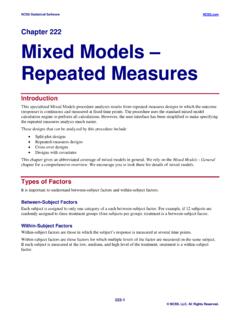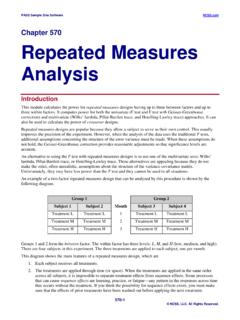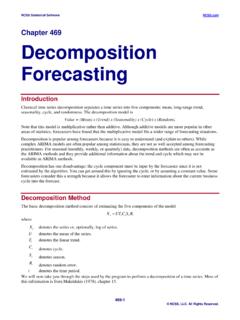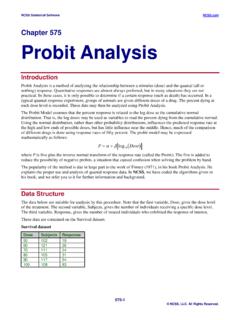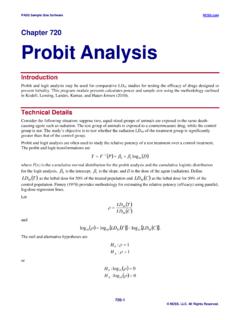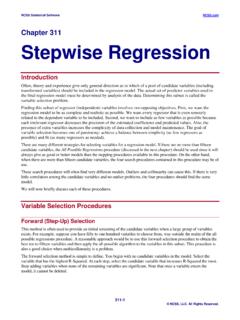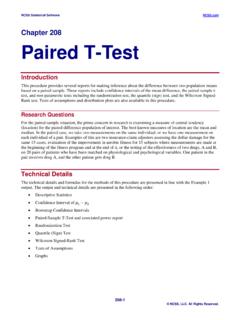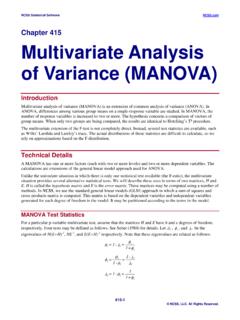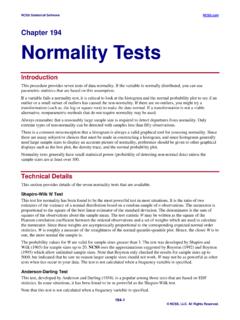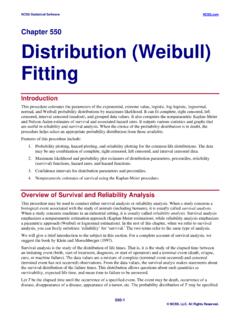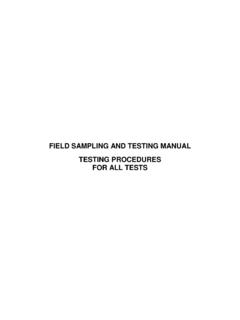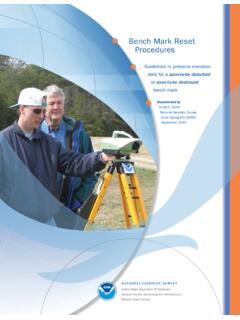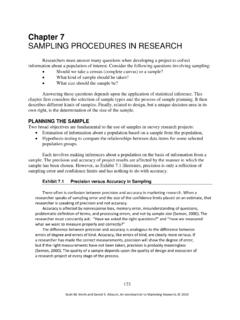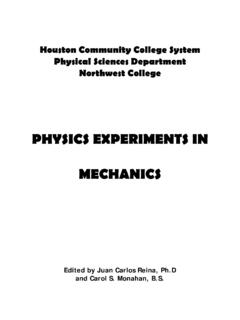Transcription of Zero-Inflated Negative Binomial Regression
1 NCSS Statistical Software Chapter 328. Zero-Inflated Negative Binomial Regression Introduction The Zero-Inflated Negative Binomial (ZINB) Regression is used for count data that exhibit overdispersion and excess zeros. The data distribution combines the Negative Binomial distribution and the logit distribution. The possible values of Y are the nonnegative integers: 0, 1, 2, 3, and so on. The results presented here are documented in the books by Cameron and Trivedi (2013) and Hilbe (2014) and in Garay, Hashimoto, Ortega, and Lachos (2011). This program computes ZINB Regression on both numeric and categorical variables. It reports on the Regression equation as well as the confidence limits and likelihood. It performs a comprehensive residual analysis including diagnostic residual reports and plots.
2 The Zero-Inflated Negative Binomial Regression Model Suppose that for each observation, there are two possible cases. Suppose that if case 1 occurs, the count is zero. However, if case 2 occurs, counts (including zeros) are generated according to the Negative Binomial model. Suppose that case 1 occurs with probability and case 2 occurs with probability 1 - . Therefore, the probability distribution of the ZINB random variable yi can be written + (1 ) ( = 0) if = 0. ( = ) = . (1 ) ( ) if > 0. where i is the logistic link function defined below and g(yi) is the Negative Binomial distribution given by 1. ( + 1 ) 1 . ( ) = Pr( = | , ) = . ( 1 ) ( + 1) 1 + 1 + . The Negative Binomial component can include an exposure time t and a set of k regressor variables (the x's).
3 The expression relating these quantities is = (ln( ) + 1 1 + 2 2 + + ). Often, 1 1, in which case 1 is called the intercept. The Regression coefficients 1, 2, , k are unknown parameters that are estimated from a set of data. Their estimates are symbolized as b1, b2, , bk. 328-1. NCSS, LLC. All Rights Reserved. NCSS Statistical Software Zero-Inflated Negative Binomial Regression This logistic link function i is given by . =. 1 + . where = (ln( ) + 1 1 + 2 2 + + ). The logistic component includes an exposure time t and a set of m regressor variables (the z's). Note that the z's and the x's may or may not include terms in common. Solution by Maximum Likelihood Estimation The Regression coefficients are estimated using the method of maximum likelihood. The logarithm of the likelihood function is = 1 + 2 + 3 4.
4 Where 1. 1 = ln + (1 + ) . { : =0}. 1. 2 = ln( + 1 ). { : >0} =0. 3 = { ln( !) ( + 1 )ln(1 + ) + ln( ) + ln( )}. { : >0}.. 4 = ln(1 + ). =1. The gradient of is 1. (1 + ) 1 . = + , = 1, 2, , . + (1 + ) . 1. 1 + . { : =0} { : >0}.. = , = 1, 2, , . + (1 + ) . 1. 1 + . { : =0} =1. 1. (1 + )ln(1 + ) 1 ln(1 + ) . = + 2 + 2. + . 2. (1 + ) (1 + ) 1. + 1 + (1 + ). { : =0} { : >0} =0. The second derivatives are 1. 2 ( 1) (1 + ) 1 (1 + ) . = 2 , , = 1, 2, , . 1. (1 + )2 (1 + ) + 1 (1 + )2. { : =0} { : >0}. 1 . 2 (1 + ) . = 2 , , = 1, 2, , . (1 + ) 1 + 1 (1 + )2. { : =0} =1. 328-2. NCSS, LLC. All Rights Reserved. NCSS Statistical Software Zero-Inflated Negative Binomial Regression 1. 2 (1 + ) 1. = = 1, 2, , ; = 1, 2, , . 1 + 1 2. { : =0} (1 + ). 1 1 1+ 1. 2. 1 + + 1 + + 1 + ln 1 +.
5 = 2. 2 1. { : =0} 2 1 + 1 + + 1 . ( ). + . (1 + )2. { : >0}. = 1, 2, , . 1. 1. 2 1 + 1 + ln 1 + . = 2 = 1, 2, , . 1. { : =0} 2 1 + + 1 . 2 1 + 2 3. 2. = + ( 5 + 6). 4. { : =0} { : >0}. where 1 1 1. 1 = 2 2 (1 + ) + (1 + ) + 3 (1 + ) + 1 + 2 . 2 = (1 + )2+1/ ln2 (1 + ). 1 1 1. 3 = 2 (1 + )ln(1 + ) (1 + ) + (1 + ) + (1 + ) + 1 + 1 . 1 2. 4 = 4 (1 + )2 (1 + ) + 1 . 2 2 + 3 2 2 (1 + )2 ln(1 + ). 5 =. 3 (1 + )2. 1. 2 + 1. 6 = . ( 2 + )2. =0. Distribution of the MLE's The asymptotic distribution of the maximum likelihood estimates is multivariate normal as follows 1. 2 2 2 .. 2 2 2 .. N .. 2 2 2 .. 2 .. 328-3. NCSS, LLC. All Rights Reserved. NCSS Statistical Software Zero-Inflated Negative Binomial Regression Akaike Information Criterion (AIC). Hilbe (2014) mentions the Akaike Information Criterion (AIC) as one of the most commonly used fit statistics.
6 It is calculated as follows = 2[ ]. Note that k is the number of predictors including the intercept. Residuals As in any Regression analysis, a complete residual analysis should be employed. This involves plotting the residuals against various other quantities such as the regressor variables (to check for outliers and curvature) and the response variable. Raw Residual The raw residual is the difference between the actual response and its expected value estimated by the model. Because we expect the variances of the residuals to be unequal, there are difficulties in the interpretation of the raw residuals. However, they are still popular. The formula for the raw residual is = (1 ). Pearson Residual The Pearson residual corrects for the unequal variance in the residuals by dividing by the standard deviation of y.
7 The formula for the Pearson residual is (1 ). =. (1 )[1 + (1 + )]. Variable Selection Because of the complexity of the model, this routine does not have a direct variable selection capability. A. reasonable stepwise strategy is as follows: remove the model term (other than the intercepts ) with largest p-value over and rerun. Repeat until all p-values are less than a threshold such as 328-4. NCSS, LLC. All Rights Reserved. NCSS Statistical Software Zero-Inflated Negative Binomial Regression Data Structure At a minimum, datasets to be analyzed by ZINB Regression must contain a dependent variable and one or more independent variables. Long (1990) presents a dataset of 915 rows that he uses as an example in his Regression book: Long (1997). This dataset contains five independent variables (Female, MentorArts, Prestige, Married, Children) and one dependent variable (Articles).
8 Long 1990 dataset Female MentorArts Prestige Married Children Articles 0 8 1 2 3. 0 7 0 0 0. 0 47 0 0 4. 0 19 1 1 1. 0 0 1 0 1. 0 6 1 1 1. 0 10 1 1 0. 0 2 1 0 0. 0 2 1 2 3. 0 4 1 1 3. Missing Values If missing values are found in any of the independent variables being used, the row is omitted. If only the value of the dependent variable is missing, that row will not be used during the estimation process, but its predicted value will be generated and reported on. 328-5. NCSS, LLC. All Rights Reserved. NCSS Statistical Software Zero-Inflated Negative Binomial Regression Example 1 Zero-Inflated Negative Binomial Regression using the Long 1990 Dataset Long (1997) discusses a dataset used as an example of Zero-Inflated Negative Binomial Regression . This dataset contains five independent variables (Female, MentorArts, Prestige, Married, Children) and one dependent variable (Articles).
9 These variables are defined as follows Articles Number of articles published during the last 3 years of Female 1 if female scientist; 0 if male scientist. MentorArts Number of articles published by the scientist mentor during the last 3 years. Prestige Prestige of the scientist's department. Married 1 if married; 0 otherwise. Children Number of children 5 or younger. The dataset can also be used to validate the program since the results of this model are given in Long (1997), page 246. In this example, we will fit a Zero-Inflated Negative Binomial Regression model to these data. Setup To run this example, complete the following steps: 1 Open the Long 1990 example dataset From the File menu of the NCSS Data window, select Open Example Data. Select Long 1990 and click OK.
10 2 Specify the Zero-Inflated Negative Binomial Regression procedure options Find and open the Zero-Inflated Negative Binomial Regression procedure using the menus or the Procedure Navigator. The settings for this example are listed below and are stored in the Example 1 settings template. To load this template, click Open Example Template in the Help Center or File menu. Option Value Variables Tab Dependent Y .. Articles Numeric X's .. Female, Married, Children, Prestige, MentorArts Numeric X's .. Female, Married, Children, Prestige, MentorArts Models Tab Terms .. 1-Way Terms .. 1-Way Reports Tab Run Summary .. Checked Means .. Checked Regression Coefficients .. Checked Estimated Equation .. Checked Rate Coefficients .. Checked Residuals .. Checked 328-6. NCSS, LLC.
